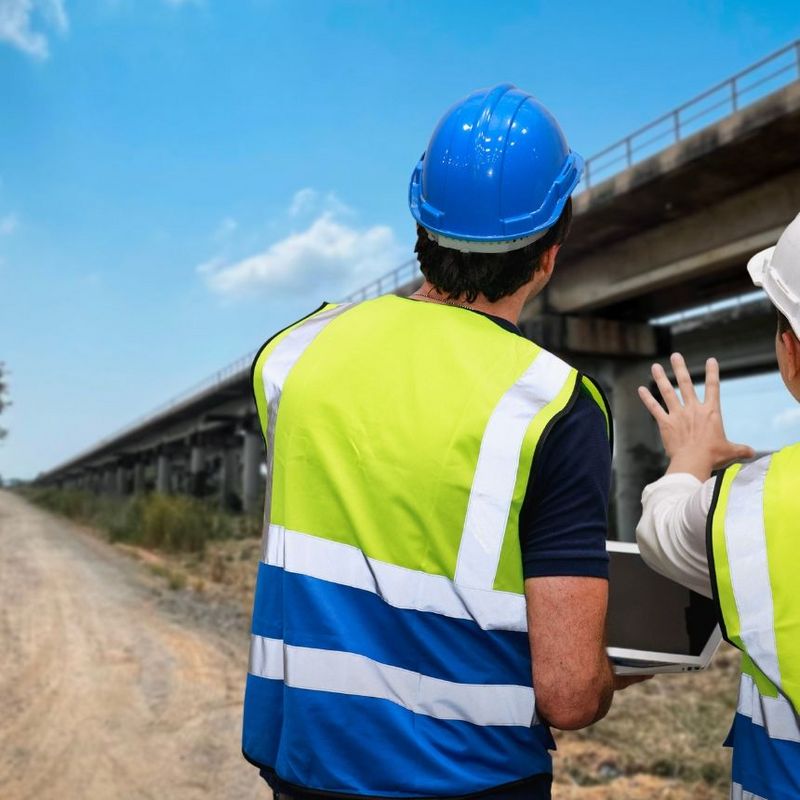20 October 2022
It’s crash test dummies who pay with their bodies for the information we need to determine what happens to the occupants of cars or pedestrians in road accidents. And the dummies are becoming ever more lifelike.
The anticipated rain has stayed away. Only a few clouds dot the blue sky above the crash test facility on the outskirts of Münster. The spectators have gathered behind the reinforced panes of the glazed stand as the signal is given by director of the experiment Kai Schulte. On cue, the sacrificial car races up and slams into the blue SUV blocking the track at 60 km/h. The car’s wheels briefly leave the ground before touching down again on the asphalt. The passenger side has been massively deformed.
The figure behind the wheel is not a Thor dummy riddled with sensors, of the kind used in approval testing or the NCAP test. The mannequin being used here is a biofidelic dummy. This descriptor does not mean that it willingly submits to accidents in a cheerful state of mind. The word “biofidelic” describes a system of modelling of the human body that is as true to life as possible, explains Mirko Dobberstein, managing director of crashtest-service (CTS), who is busy evaluating the initial data on a laptop perched on the boot of the sacrificial car.
An older approach with a future
The idea behind the dummy came to accident researcher Michael Weyde a good 20 years ago. This expert is the first port of call for the state attorneys’ offices in Berlin when it comes to evaluating accidents. Since 2016, for instance, Weyde has investigated a fatal high-speed crash on the Kurfürstendamm in Berlin and the notorious attack on the city’s Breitscheidplatz, both of which took place that year. His analyses are used by the courts to help them arrive at a verdict. After all, misinterpretations can have grave consequences for the accused or the victims. Weyde found that it was not possible to reconstruct accidents involving pedestrians in a realistic manner with the conventional dummies in use at the time. Their bodies, made of steel and plastic, were simply too rigid. Instead of suffering broken bones, as real people would in impacts with car bumpers, they instead caused unrealistically serious damage to the vehicles.
This prompted Weyde to start redesigning the standard dummy to make it more realistic. The aim was to create a dummy which would replicate the human body is closely as possible, including its patterns of motion. In other words, a dummy which would cause a realistic degree of damage to a vehicle. And one which would make it possible above all to get an improved and more direct picture of the kinds of injuries which would be sustained, rather than relying on sensors. In 2010, Weyde unveiled his first biofidelic dummy. This dummy is now being further developed at the University of Applied Sciences in Dresden (HTW) under the direction of Professor Lars Hannawald and built in the dummy laboratory run by CTS in Münster.
© Frederic Scheidemann
The biofidelic dummy is intended to model its human template as closely as possible.
Artificial bones, tendons and soft tissue
Recent years have seen quite a bit of development in this field. Where accident researcher Weyde initially used wood to simulate bones, the dummies’ skeletons are now cast using epoxy resins. “These have similar breakage properties to human bones,” says engineer Dobberstein. Just like their humanoid model, the dummies have joints, tendons and ligaments which will rupture or tear under strain. As Dobberstein explains, soft tissues such as muscles and fat are simulated using medical silicone. “These materials are similar to human tissues, including their hysteresis properties.” In other words, just like our body fat, they will deform when subjected to pressure – a key reason why biofidelic dummies move like people when they get hit by cars, whereas the bodies of conventional dummies simply cartwheel away. Biofidelic dummies are also protected by a layer of skin. This consists of a neoprene-latex combination and, just like ours, will sustain grazes and cuts in the event of an accident.
After an accident, an autopsy is carried out on the dummy, as it would be with a human subject. It can also be X-rayed. This means that the crash test dummy’s skin does not need to be cut open after every impact. Most significantly of all, accident researchers can directly compare the X-ray images taken from the dummy with real injuries sustained in other investigated accidents.
Nor are the injuries suffered by car occupants limited to cuts or broken bones, of course. “Even slight acceleration can result in anything from concussion to cerebral contusions of varying severity,” says Mirko Dobberstein. It’s for this reason that the biofidelic dummies too are equipped with sensors to measure values such as acceleration and rotation rate. “These data can be used to determine head injury criteria.”
© Frederic Scheidemann
Cutting open or shining a light through: the biofidelic dummy can be autopsied or X-rayed.
© Frederic Scheidemann
The dummy’s bones are cast using epoxy resins and break very much like our own.
A question of comparability
In this respect, in technical terms biofidelic dummies resemble their sensor-studded counterparts. These are also constantly being improved. For instance, compared to its predecessor, the current Thor dummy has a more realistic spine and a significantly greater number of more sensitive sensors whose data can now be used to draw conclusions about possible facial injuries. Most importantly, the standard dummies now provide comparable and reproducible measurement data. This means that they are irreplaceable when it comes to standardisation tests and the ability to compare the safety of different vehicle models in the context of the NCAP test. The biofidelic dummy is thus not intended to replace its predecessors in these areas, says Peter Schimmelpfennig, managing partner at CTS. But it is being lined up to supplement the work carried out in those scenarios where standard dummies come up against their limits.
Away from the area of accident analysis for courts or research institutes, the biofidelic dummy is also proving useful as a training object for the emergency services and in explosives tests. It is currently also being used to reconstruct accidents involving roller-coasters and other leisure park rides. Ballistics laboratories in Germany use the anthropomorphic crash test dummy to test armoured vehicles, such as those used to safely ferry politicians around. With the dummy behind the wheel or on the back seat, for instance, tests are run to establish whether the vehicles offer reliable protection from machine gun fire, grenades or mines.
And the dummy itself is also coming directly under fire – for instance, in the testing of bulletproof vests. “Earlier tests were just about seeing if bullets would penetrate the vest. But that doesn’t help if the person wearing the vest suffers multiple rib fractures due to the projectile impact and dies as a result,” Peter Schimmelpfennig explains. The tests using the biofidelic dummy are accordingly intended to improve the vests’ energy-absorbing properties.
About
© Frederic Scheidemann
Peter Schimmelpfennig, managing partner at CTS.
Test passenger for self-driving buses
The dummy might also be called upon in future to sacrifice its head and body in self-driving buses. After all, the seating arrangements for bus passengers are different from those in a car, for which conventional dummies are designed. But Peter Schimmelpfennig is convinced that supplementary tests using the biofidelic dummy would already be capable of further improving the safety of vehicle occupants. Standard dummies with their limited range of movements always land neatly on the airbag, but, as Schimmelpfennig says, this often ignores the reality of what happens in real traffic scenarios, as hardly anyone ever drives straight into a wall from a ninety-degree angle. “In reality we’re able to observe how occupants can slip past the front airbags. With this in mind, I see a great deal of potential here for the ongoing optimisation of airbag systems based on tests using the biofidelic dummy.”
And yet, the biofidelic dummy itself also needs to become ever more realistic and to simulate more and more aspects and functions of the human body. Internal organs would be an interesting addition, Dobberstein says. After all, breaking bones can also damage arteries – with lethal consequences. As things stand, artificial blood vessels are still a long way off. Nor does the dummy yet boast active musculature. Its behaviour is currently still like that of an unconscious person. Which, according to Benjamin Härtel, who has played a key role in the development of the dummy at HTW Dresden, is quite sufficient for most test scenarios. This is because, if a car hits a wall at 60 km/h, the acceleration force is so massive that the impact of muscular tension is negligible. “However, when it comes to lower collision speeds, active muscle tone, especially in the neck, does make a difference. And this is being researched,” Härtel says.
New additions to the family for average values
As a first step, the biofidelic dummy could soon be joined by a new family member. At 1.78 metres tall and weighing 78 kilos, the original corresponds to a man on the 50th centile, thus covering 50 percent of all men in Europe and 30 percent of women. It therefore corresponds to the type of dummy used in most standardisation and NCAP crash tests. However, it is not yet capable of simulating unusually tall men, very small women or children, but this is set to change. A juvenile dummy is way up on the developers’ list. Although it won’t be sufficient simply to make the big dummy smaller and lighter, says Mirko Dobberstein. This is because children have more flexible and elastic bones and different biomechanics: “This means that we need to build a completely different dummy.”
Until things get to that point, the anthropomorphic test body is also going to enjoy a somewhat quieter life away from the road – as a test sleeper for a mattress producer. As can be seen, biofidelity is in demand in many fields.
About
© Frederic Scheidemann
CTS managing director Mirko Dobberstein evaluates the initial data straight after the crash.








